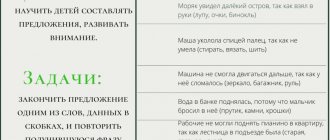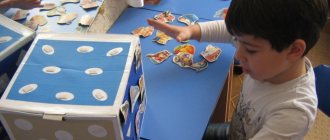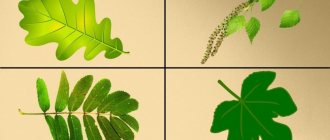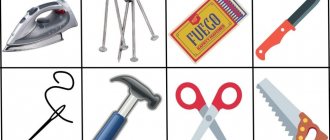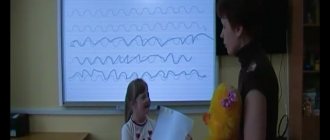Construction games
Construction games.
Younger age.
“Let’s build a doll shop.”
Target
: To consolidate the ability to build a store from cubes and bricks, to bring the job to the end, to cultivate friendly relations in the game.
A game:
The teacher brings small dolls into the group. Everyone has a handbag. He asks: “Why did our dolls take the bags?” Together they decide that the dolls are going to the store, but they can’t find it. Children are invited to help the dolls and build a store out of cubes and bricks. The guys build: some - according to the model given by the teacher, some - on their own.
"Zoo for wild animals."
Target:
Strengthen the skills of joint activities with the teacher (build cages for animals); continue to learn how to play around with your construction.
A game:
The teacher shows toys - figurines of wild animals, clarifies where they live, and together with the children decides to build a zoo for them.
"Zoo".
Target:
Strengthen the ability to build houses for different animals from cubes; develop respect for animals.
A game:
The teacher reminds that animals at the zoo have houses where they hide from the rain, and makes them want to build houses for them. On the table is a set of figurines of wild animals. After construction is completed, they play with them.
"Let's build a house for animals."
Target:
Develop memory, speech; Encourage children to create variations of designs by adding other details.
A game:
Children are asked to choose one or two pets and build a house for them using building parts.
"Garage".
Target:
Strengthen the ability to build from parts of a large builder; beat the building.
Game:
Game situation:
small cars are standing in different places, and it’s hard to find the one you need. The teacher clarifies where the cars “live” and leads the children to the idea that they need to build garages. The guys choose their own car and build a garage for it themselves. If desired, additional structures can be added. Then, if they want, they play with the buildings.
"Let's build a house for a bunny."
Target:
Develop children’s constructive skills, the ability to demonstrate how to build simple structures, and enjoy the results; consolidate the names of details and verb forms in speech; develop motor skills, the ability to correlate movements with words.
A game:
The snow bunny came running, but he had nowhere to live...
"Let's build a house for the bear."
Target:
Develop children’s constructive abilities, teach them to correlate the size of a building with the size of an object; consolidate knowledge about construction details; develop the planning function of speech.
A game:
Three bears from a fairy tale come to visit the children and ask them to build a house for them, each separately.
"Terem for animals."
Target:
Develop children's constructive skills, learn to compare buildings with the size of an object, learn to pronounce a sequence of actions in speech.
A game:
The bear destroyed the animals' mansion; they have nowhere to live.
"At the request of the children."
Target:
Improve children's skills when working with construction sets, learn to decorate the design, play with it; bring pleasure from games and collective activities.
Middle group.
"Garages for cars."
Target:
Strengthen your knowledge of the names of building materials; cultivate the desire to build together, amicably.
Main content:
children are invited to build garages of different sizes and shapes.
"House for gnomes."
Target:
Strengthen the ability to design objects (houses) in accordance with certain conditions.
Main content:
children build houses of different designs.
"Furniture for a doll."
Target:
To develop children’s constructive abilities, the ability to create simple buildings; consolidate knowledge about furniture and its purpose.
“Construction of houses for kittens of different sizes.”
Target:
To consolidate knowledge of the concepts “big - small”; develop constructive skills, speech.
A game:
The doll draws attention to the fact that the kittens meow pitifully because they have no homes and are cold. Asks the children to build houses for the kittens from building material according to the size of the kittens so that they fit in the house.
"Trucks".
Target:
Develop children's constructive abilities, fine motor skills of fingers, learn to build cars from LEGO construction sets; learn to play without conflicts, in harmony.
"Garages for transport."
Target:
Teach children to organize themselves into groups and unite with a common plot, teach them to play without conflicts, in harmony. Offer small toys to play with.
Senior group.
"Autumn in the forest."
Target:
Mastering the methods of constructing a landscape composition.
A game:
From geometric shapes of different colors, sizes, shapes, create a picture - a landscape.
"Home for Thumbelina."
Target:
Strengthen your skills in working with paper and cardboard; develop precision of movements, attention, perseverance, interest in activities, speech.
A game:
Thumbelina has nowhere to live and the children, using colored paper, matchboxes, glue, brushes, scissors, napkins, make furniture and arrange a home for Thumbelina in a box.
"Gifts for Kids."
Target:
Increase children's self-esteem; practice manual skills; bring joy from handmade crafts.
A game:
Samodelkin invites the children to make gifts for the little ones; during New Year's week everyone should receive gifts. So that the children don’t feel sorry for giving, Samodelkin suggests making two crafts.
"A mosquito made of natural material."
Target:
Develop fine motor skills of the fingers and precision of movements; strengthen the skills of connecting parts of a craft; consolidate knowledge about the appearance and distinctive abilities of insects; teach how to pronounce preparation for work, the sequence of actions.
Material:
maple lionfish, dried leaves, acorns, sticks, thin wire, plasticine.
"Insects from natural materials."
Target:
Strengthen knowledge about insects; offer to choose from natural materials suitable components for the insect they want to make.
"Making crafts - frogs from paper."
Target:
Strengthen the ability to fold paper crafts; develop accuracy of movements, eye, attention, perseverance.
A game:
So that the frog Zhanna does not get bored, we need to make her girlfriends. Play with crafts: whose frog will jump the farthest. Fill the paper lilies on the “pond” with frogs.
"In the world of fantasy."
Target:
Invite children to fantasize, dream of building a fantastic city on another planet, come up with a name for it and what the inhabitants will be called. Teach children to build buildings collectively, plan upcoming work together, and carry out their plans together.
"Builders".
Target:
To develop children's creative imagination and the ability to jointly develop play using construction sets and building materials.
"Children's Choice"
Target:
Teach children to build buildings and unite in one group, together come up with a plot and play it out. Learn to play together, not quarrel, give in to each other.
"Beautiful buildings".
Target:
Teach children to build buildings, uniting in groups, inventing stories and acting out them. Learn to make buildings that are sustainable, diverse, and coordinate individual plans with the general one.
"My city".
Target:
Learn to creatively implement a plan, develop imagination, consult with peers when performing work, distribute responsibilities.
"Garages and cars."
Target:
Teach children to organize themselves into groups and unite with a common plot, teach them to play without conflicts, in harmony. Offer small toys to play with.
Preparatory group.
"Playground".
Target:
Activate the ability to create object structures from building materials according to the conditions. Improve constructive skills.
A game:
children are offered wooden building material with attributes to play with - cars, trees, figures of people, etc.
"Let's build a house in the village."
Target:
Develop children's constructive skills, ingenuity, imagination, ability to navigate in space; activate your verb dictionary.
A game:
offer to build the kind of house they would like to have; suggest that you first draw it schematically, and then build it using a builder and decoration elements.
"Napkins for the festive table."
Target:
Develop aesthetic taste, the ability to do something with your hands; make you want to do something nice.
A game:
Invite children to cut out napkins for tables, decorating the edges in different ways.
"Magic Glade".
Target:
Strengthen the ability to engage in collective activities, develop aesthetic taste, the ability to compose a composition, and navigate on a sheet of paper; develop imagination and creative thinking.
A game:
invite children to imagine that they are in a magical meadow and it needs to be decorated with beautiful flowers. Think about what flowers will be, color, shape, how to place them and where. Make not only flowers that children know, but also fabulous, unusual flowers.
"Architects".
Target:
To develop children's creative imagination and the ability to jointly develop play using construction sets and building materials.
Get text
Card index of games on Lego construction (compiled by teacher of MBDOU 45 Zvezdina E.V.)
Transcript
1 Card index of games on Lego construction (compiled by teacher MBDOU 45 Zvezdina E.V.) “The fourth odd one” Goal: to develop attention, intelligence, evidentiary speech Progress of the game: Look and say which detail is extra. “Colorful details” Goal: Development of sensory skills. Children are offered construction sets of different colors (red, yellow, green, blue) and baskets; they need to place construction sets of the same color into baskets. "What changed?" Goal: development of attention, coherent speech, ability to describe an object. Progress of the game: Lego objects are placed on the table in a certain sequence. Educator: look carefully at the objects, remember how they are located. Then, when you look away, I'll change something. When you turn back, you must carefully look at how the objects are lying and tell me what has changed? Complication: Describe an object that was not told about the place where it stood, what sound did the name of this object begin with, what other objects have this sound in the name? “Multi-colored chest” Purpose: to teach children to focus on the ending of the word when agreeing neuter (feminine) nouns with a pronoun. Material: box, subject pictures according to the number of children. Educator: I put the pictures in a multi-colored chest. Come on, Ira, take a look, take out the picture, name it. Children take out a picture and name the building that is depicted on it. “Tell me which one?” Goal: To teach children to identify the characteristics of an object. The teacher (or child) takes objects out of the box, names them, and the children point out some feature of this object. If the children find it difficult, the teacher helps: “This is a cube. What is he like? “Assemble Lego bricks” Purpose: To consolidate knowledge of primary colors. Equipment: Lego bricks of 4 colors. Four children playing. The teacher scatters Lego bricks on the carpet, places the boxes, distributes what color bricks should be put in the box. Children choose the color they will collect. At the command “Start!” children collect bricks. The one who collects the fastest wins.
2 “Assemble a model from memory” The teacher shows the children a model of 3-4 parts for a few seconds, and then removes it. Children assemble the model from memory and compare it with the sample. “Count and name” Purpose: helps to consolidate grammatical structures. Progress of the game: - let's play a game, I have one Lego Christmas tree, but tell me how many there will be. For example: one cube and there will be many cubes. -I have one Christmas tree, how many Christmas trees do you have? -How many Christmas trees does Katya have? (4) -Katya give one Christmas tree to Lisa. How many Christmas trees does Lisa have? -Count how many Christmas trees you have? “Tower” Goal: fix prepositions (on, under, between) Progress of the game: You have bricks of different colors on your table, 1. place the bricks on a brick, build a tower (ON) 2. at the bottom there was red and at the top yellow (preposition under) 2. place the brick so that the blue brick is between the red and green bricks - Now we will tell you about your design: there is a yellow brick on the table, continue. -Under the red there is a yellow brick -Between the red and green there is a blue brick “Mosaic” Purpose: promotes the development of sensory standards, namely the consolidation of size, shape and color. How to play: Assemble a snake from green and yellow Lego pieces. -build a tower, one larger than the other -When collecting a snake, what kind of snake can you make? (winding, straight, long, short) -Tell me about your tower, what is it like? What geometric shapes are they made of? -What colors are present in your tower? -How many cubes are used to build a high tower and a low one? "Where is your home?" Goal: Development of meaningful perception of the shape of geometric figures; recognizing the shape of a figure only with the help of a visual analyzer. Material: Small cards depicting geometric shapes: circle, square, oval, rectangle, triangle for each child; five large cards depicting the same figures. The teacher calls four children over and gives each of them a large card with the identification mark of the new house into which the residents will move. Children with cards take their places (stand in the drawn circles). The rest of the game participants receive small cards that invite them to move to a new home.
3 Q. There is a figure drawn on the invitation that will help you find a new home. In order not to confuse your house with someone else’s, you need to carefully examine all the figures on the houses and choose the same one as on the card. After this, the children move freely around the playground for some time. They don’t yet know where whose house is, because... They had not yet been shown large maps. At the teacher’s signal “Stop,” children with large cards (owners) will pick them up, and children pretending to be residents will have to stop, look at their cards, and then look for where the same figures are on the houses. After a short pause, the teacher asks: “Where is your home?” After these words, the children run away to their homes. Once the house is completely occupied, all residents raise their cards. The teacher and the “owners” of the houses check in which house the residents gathered first and whether everyone has found their house correctly, notes the winners. Then the adult collects small and large cards, selects new “hosts,” distributes new invitations, and the game is repeated. “Outlines” Purpose: To introduce children to the ability of geometric shapes to “turn” into various objects. Development of imagination. Dictionary development. Preparing your hand for writing. Material: Geometric shapes. Colour pencils. The teacher tells the children some story or fairy tale (the topic is chosen by the teacher). Then the children are given a geometric figure (or several), asked to circle it and finish drawing it so that it turns out to be a hero of the story or an object. “Architect” Goal: To develop the ability to compose a serial series. Train your child in the ability to create a construction plan. Material: Strips of different lengths (up to 10 gradations); a sheet of paper, a simple pencil. Arrange the strips in disarray. Invite the children to draw a plan for the staircase without touching the stripes. Then, offer to take the strips and build the stairs according to the plan. “Recognize the object” Goal: Recognize a schematically depicted object. Build an item from builder parts; make up of geometric shapes. Material: Schematic images of various objects; geometric figures; construction details. The child is shown a picture with a schematically depicted object. He must recognize it and build it from the builder’s parts, independently selecting the necessary parts. “Find out what has changed” Purpose: To train children in correctly determining the spatial arrangement of objects: to the right, to the left, in front, behind, on the side, near, etc. To develop observation and active memorization. Fix the name of geometric shapes or construction parts.
4 Material: Geometric shapes or wooden construction parts; Parsley; screen. The children help Petrushka figure out where the objects are. Behind the screen, objects change places. Only those children whom Parsley points out name the change in the arrangement of objects. Complication: The number of parts increases; swaps the places of more than two objects. “Hot and cold” Purpose: To reinforce in children the names of the parts of a wooden construction set. Develop coherent speech. Material: Designer parts; matryoshka Examine the details with the children, place them so that they are clearly visible and so that they can be approached. Q. Today we will play the game “Hot and Cold”. Let's choose a driver. He will go out the door, and we will hide the nesting doll behind some detail. If he sees a nesting doll behind a part, he must name it, and only after that can it be taken. We will help the driver, if he has gone far, we will say: “Cold,” if he is close, “Warm,” if he is very close, “Hot.” The leader is chosen using a counting rhyme. The number of parts depends on the age and level of preparedness of the children. “Happy Island” Goal: Development of imagination. Skill to work in team. Reinforcing the names of geometric shapes. Material: Multi-colored geometric shapes and their parts. The teacher determines the topic. Children create a building together. The construction must correspond to the nature of the theme. “Find by description” Purpose: To teach how to find a building by description; develop observation skills; learn to describe a building without naming it; cultivate endurance. Material: Ready-made buildings (in the sub-group you can use three-dimensional diagrams); Pinocchio toy. The teacher, together with Pinocchio and the children, examines the buildings. At the same time, the teacher pays attention to what parts the building consists of, how they are located relative to each other, what functional parts there are, and why this item is needed. V. Now Buratino and I will make a wish for one of the buildings, and Buratino will tell you about it. The one whom Pinocchio points to will name the hidden building. Pinocchio describes the construction and the children guess it. Option. The child describes the building. Pinocchio guesses. The game continues until all buildings have been guessed. Then Pinocchio offers the children small toys to play with the buildings. “Different houses” Purpose: To teach children to compare a drawing and a drawing (diagram) of an object. Material: Cards with contour images of buildings of complex shape (houses with different roofs, extensions). Children are offered 4 schemes. Three each
5 detailed pictures for each diagram. In each picture there is a slight discrepancy with the diagram: the difference is in the shape of the roof of one of the extensions, in the location of the extensions, in their height, etc. An adult tells the children that once the builders were building a house according to the drawing and made small mistakes. And although the houses turned out beautiful, they were still a little different from the drawing. Offers to examine each building and find inaccuracies. The teacher shows the children the first diagram and a picture for it. Children find a mistake. Then the teacher shows the next picture for the same diagram, then the third. Next, they move on to the second scheme and examine three more pictures in succession. If the children cannot find the correct answer, the teacher helps them. The rest of the drawings and drawings are treated in the same way. In this game you can use a variety of drawings and designs. “Guess” Purpose: Teaching children to adhere to a certain plan when analyzing a subject, i.e. sequentially asking a series of questions, first of a general nature, about the purpose of the object, its appearance as a whole, and then more specific questions about the parts of the object, their features and structure. Material: A set of drawings depicting various objects, buildings (a hut on chicken legs, an airplane, a swing, an ice palace, a bridge, etc.) The pictures are located in front of the children. An adult invites the children to play the game “Guess It.” He will guess the object that the children themselves will choose from several shown in the pictures. The adult asks questions, and the children answer only “yes” or “no.” Questions might be something like: “Is this a common item? No. Is this a fairy tale item? Yes. Is it used for transportation? No. Do they live in it? Yes. Is it on chicken legs? Yes. Is this Baba Yaga's hut? Yes".
